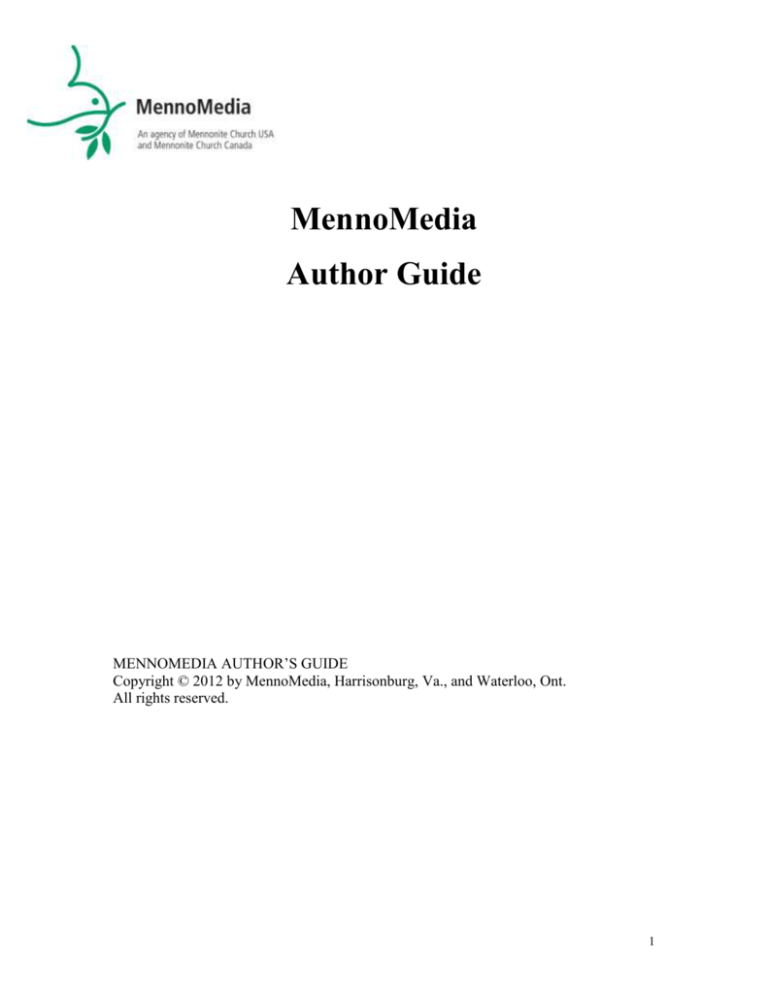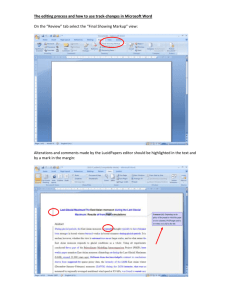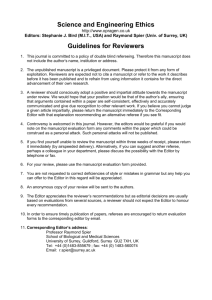
MennoMedia
Author Guide
MENNOMEDIA AUTHOR’S GUIDE
Copyright © 2012 by MennoMedia, Harrisonburg, Va., and Waterloo, Ont.
All rights reserved.
1
1. Introduction
MennoMedia engages and shapes the church and society with resources for living the
faith from an Anabaptist perspective. MennoMedia publishes books, curriculum, worship
resources, church supplies, magazines, and DVDs for Mennonites, their congregations,
and for readers of all religious and secular traditions. Books for the trade market carry the
Herald Press imprint; resources for all other markets carry the MennoMedia imprint.
The purpose of this document is to help you prepare your manuscript for editing
after it has been accepted for publication by MennoMedia.
For spelling and word usage, MennoMedia follows Miriam Webster’s Collegiate
Dictionary (Eleventh Edition, 2003).
On matters of style, consult MennoMedia’s Manual of Style, which can be
downloaded as a PDF or Word document at Herald Press.com. MennoMedia also follows
the Chicago Manual of Style (16th edition).
2. Workflow: From Acceptance to Publication
Preliminary work on your manuscript
After your manuscript has been accepted for publication and you have signed and
returned your author’s contract, your book will be assigned to an editor.
You may have already completed an Author Form, or the editor will send it to
you. Here you will provide us with personal and biographical information, such as the
correct spelling of your name, your address, and date of birth. You will be asked to
summarize your book and to provide a brief biography that includes any other work you
have published.
The editor will use this information to begin preliminary work, such as
registration with the Library of Congress, asking for endorsements, and informing
contacts about your upcoming book.
The editing phase
Editorial work usually begins about six or more months prior to a book’s publication.
Once the editor is in possession of the final draft, the editor will read and edit the
manuscript for correct style, word usage, and other mechanics. The editor will assess the
overall flow, structure, organization, and congruency of the manuscript.
Any artwork, such as photos, graphics, diagrams, tables, etc., will also be
collected and reviewed. None of this material should be embedded in the body of the
manuscript. It should be forwarded to the editor separately from the manuscript. (See
Preparing Your Manuscript for Submission for guidelines on handling art and
graphics.)
After the first edit, the manuscript will be sent to a copy editor, who will examine
the manuscript in even more detail. It will be checked for correct grammar, punctuation,
and for the accuracy of name and place spellings, use of numbers, and similar issues.
After the editor and copyeditor have reviewed the manuscript, it will be returned
to you for review. This will be your chance to comment on any changes to your work and
to respond to any author queries from the editors.
You can make further revisions to the manuscript using the Track Changes
function in Word. We request that any rewriting, rewording, or other editorial changes to
2
the manuscript be made at this stage of the process. Once you return the manuscript to the
editor, we will consider it to be final and will seek to avoid any further editorial revisions.
The editor generally asks for the manuscript to be returned within about two
weeks, if feasible. Should you need more time to complete your review, please consult
your editor.
After you return the manuscript, the editor will process your revisions. When this
work is finished, and when all the elements of the book, such as art and graphics, have
been received, the manuscript is sent to a designer to begin layout and typesetting.
The design phase
Also during this time, the editor will have been working with a designer on a front cover.
MennoMedia assumes responsibility for developing front covers and normally bears the
cost of cover art or photographs. At the appropriate time, the editor will forward the
cover to you via PDF.
The editor will also be sending the manuscript to scholars or other authorities in
your field to seek endorsements that will be used on the cover and in other marketing
endeavors. The editor may request a foreword from a known figure who can recommend
the book to its readers.
After the book is laid out and has been typeset, it will be examined for errors by a
proofreader. When the proofreader’s work is done, the editor will forward the page
proofs to you via PDF. We will ask that you review the proofs searching mainly for
errors. We request that you limit any changes at this point to corrections that are
absolutely necessary.
Once all corrections have been entered and checked, the book and its cover are
submitted for printing. Around this time, you will also be contacted by our marketing
staff, who will handle the publicity and distribution of your book.
3. Preparing Your Manuscript for Submission
After the book is accepted for publication and your author contract has been signed and
returned, you should begin preparing the final draft of the manuscript for submission to
your editor. Besides the editorial work that will be done on the manuscript, it must also
be prepared for typesetting and layout. The guidelines below will help facilitate the
manuscript toward publication.
The manuscript should be submitted as a Microsoft Word document. If you work
in another computer or word processing program, please consult your editor.
When submitting the final manuscript, have everything in one Microsoft Word
document: front matter (containing the title, contents, dedication, lists of
illustrations, tables or abbreviations, permissions, acknowledgments, and preface),
introduction, each chapter, bibliography, and appendixes.
If your book is to contain an index, it should be completed by you before you
submit the final manuscript. Authors are asked to complete their indexes using the
indexing feature in Word.
We prefer avoidance of Greek or Hebrew letters and request that authors translate
or transliterate Greek and Hebrew words. For detailed guidelines on these uses,
3
consult the Society of Biblical Literature Handbook of Style, chapter 5,
Transliterating and Transcribing Ancient Texts.
If your book is to contain art—including photos, graphics of any kind, diagrams,
charts, tables, or illustrations—do not embed the art in the manuscript. Rather,
indicate in the text where the art is to be placed, and submit the art separately
from the manuscript. Inform your editor as soon as possible that the book will
have art. MennoMedia does not provide documentary photographs, maps, or other
graphics for the books we publish. Authors or sponsoring organizations must
supply desired photos and maps, usually at their own expense. Photos must be of
a quality suitable for publication. Maps must be camera ready, designed to fit the
format of the book. Check with the editor for specifications.
All maps and photographs must be in the hands of the book editor before Herald
Press schedules the design and manufacturing processes, establishes the retail
price, and announces the intended release date. Delays in receiving photographs,
maps, captions, and credit lines will delay the publication of the book.
When submitting photographs by mail, place each chapter’s photographs in a
separate envelope; if electronically, make sure the resolution is 300 dpi,
minimum, at snapshot size. On a double-spaced photograph log, separate from the
manuscript, label each photograph and identify the five following items of
information:
Describe the photograph in general terms.
Indicate where the photograph should appear in relation to the text. Using a
cross-referencing label (e.g., 1-1 for chap. 1, photograph 1; 1-2 for chap. 1,
photograph 2), indicate in the manuscript (using comment tool or a bracketed
line in the body] approximately where the photograph or graphic should
appear. Design and layout considerations will decide exact placement in
relation to the text.
Identify any special handling desired, such as cropping, opaquing, etc.
Suggest how much vertical space should be allotted for the photograph (e.g.,
one third page or one half page).
Provide exact wording for caption.
Provide exact wording for the credit line.
The manuscript and other material should be submitted to the editor by email.
4. Style Guidelines for Notes and Bibliographies
Consistency and clarity are vital when documenting your sources. For detailed guidelines
see the MennoMedia Style Manual chapters 7 and 8, the Chicago Manual of Style
chapters 16 and 17, or discuss any questions with your editor. Here are some general
guidelines:
Use footnotes instead of endnotes.
If the book contains a comprehensive bibliography, then endnotes need only list
the author’s last name, short title, and page numbers.
4
If there is no bibliography, then endnotes must contain full publishing info on the
first reference to the work in each chapter. On subsequent references in that
chapter, list the author’s last name, short title, and page numbers.
Footnotes should begin at 1 in each chapter.
5. Ordering copies of your book
As an author, you receive a discount on copies of your book. Refer to your author
contract for the specific discount that you receive. To get this discount, order directly
from MennoMedia at 800-245-7894 and identify yourself as an author. You will not
receive the discount if you order online; you must order via telephone to receive it.
5







